Pencetakan 3D untuk melawan COVID-19
Mengingat situasi darurat yang sedang dialami saat ini akibat penyebaran COVID-19 coronavirus, inisiatif dan solusi hebat muncul dari solidaritas dan inovasi, terutama untuk mengurangi kekurangan peralatan medis dan alat pelindung diri (APD).
Dari pencetakan 3D sektor, ada banyak insinyur dan produsen bahan yang, bersama dengan spesialis medis, bekerja untuk merancang model APD (alat pelindung diri) yang membantu menjaga kesehatan toilet dan memfasilitasi pekerjaan mereka, sehingga dalam pengembangan prototipe yang berbeda seperti katup, konektor respirator atau respirator berbantuan, dan perangkat lain yang membantu mengurangi kekurangan peralatan medis.
Selain itu, banyak komunitas pembuat telah meluncurkan printer 3D mereka untuk memproduksi perangkat ini. Di Spanyol, inisiatif Coronavirus Makers telah muncul, sebuah platform nirlaba dengan ribuan sukarelawan. Inisiatif serupa dapat ditemukan di negara-negara seperti Jerman, Italia, Cile, Argentina, atau Kolombia.
Di bawah ini kami menyusun berbagai desain alat pelindung dan perlengkapan medis yang telah tersedia untuk umum secara gratis oleh berbagai perusahaan dan asosiasi, dan dapat diunduh dalam format STL dan dicetak di hampir semua printer FDM.
Harus diingat bahwa beberapa model tidak dihomologasi atau disetujui oleh otoritas kesehatan terkait dan bahwa, bergantung pada setiap area atau negara, persyaratan manufaktur untuk mencapai homologasi ini dapat bervariasi.
Masker wajah
Baik di platform sumber daya pencetakan 3D maupun di berbagai halaman perusahaan di sektor 3D, berbagai model topeng dibagikan untuk pencetakan 3D pada semua jenis printer FDM 3D.
Harus ditekankan bahwa topeng ini , kecuali mereka memiliki filter yang diperlukan, hanya berfungsi sebagai penghalang fisik terhadap virus , selain membantu untuk tidak menyebarkannya jika terinfeksi.
Beberapa hari yang lalu kami membagikan desain topeng Nanohack yang dikembangkan oleh Copper3D tim dan yang baru-baru ini membagikan pembaruan desain topeng tersebut:NanoHack 2.0, dengan struktur monoblok, kuat dan kedap udara , yang harus diproduksi dengan filamen antibakteri PLActive dan MDFlex untuk memberikan perlindungan maksimal terhadap lingkungan eksternal.
PLActive adalah polimer yang dapat didaur ulang dan biokompatibel yang mengandung nanokomposit tembaga yang telah menunjukkan sifat antimikroba.
Berkat desainnya,NanoHack 2.0 adalah perangkat yang menawarkan perlindungan terhadap partikel di udara dan mencegah penyebaran cairan yang mencemari saluran udara. NanoHack menggunakan bahan yang sama dengan yang digunakan pada masker bedah (non-woven polypropylene) sebagai sistem filtrasi. Untuk perlindungan optimal, disarankan untuk menggunakan filter polypropylene tiga lapis bukan tenunan. Filter ini tertanam di topeng. Jadi, menurut berbagai penelitian, efisiensi filtrasi sebesar 96,4% dicapai untuk mikroorganisme berukuran 1 mikron dan 89,5% untuk mikroorganisme berukuran 0,02 mikron.
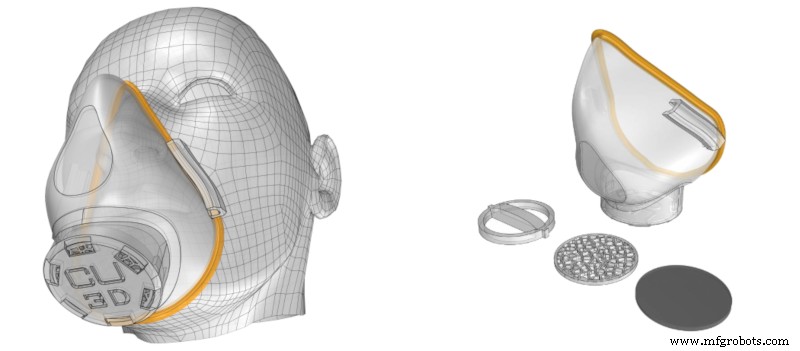
Info selengkapnya
Unduh STL
Pelindung wajah
Anda dapat menemukan berbagai model pelindung wajah dan pelindung wajah di internet. Prusa has developed several prototypes, which have been verified with the Czech Ministry of Health. Finally, they have presented two screen versions:RC1 and RC2.
 This screen design consists of a rigid structure with a flexible and transparent acetate plastic sheet. The rigid structure is 3D printed and the plastic acetate sheet is then adapted as a screen. The RC1 version allows more parts to be printed in the same printing process, while the RC2 version provides slightly higher protection and is more comfortable to wear.
This screen design consists of a rigid structure with a flexible and transparent acetate plastic sheet. The rigid structure is 3D printed and the plastic acetate sheet is then adapted as a screen. The RC1 version allows more parts to be printed in the same printing process, while the RC2 version provides slightly higher protection and is more comfortable to wear.
As a screen, the prototype uses a 0.5mm thick PETG sheet, although other transparent and flexible materials with a similar thickness can be used such as clear acetate sheets.
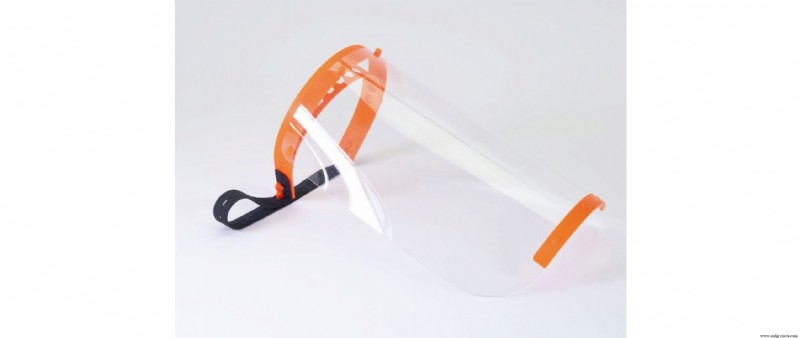
More info
Download STL from Prusa
3D printing with PETG with 30 % fill is recommended, although other materials such as PLA or ABS can be used. In order to deliver them to health centers, it's essential to sterilize them by applying a water bath with bleach (Ratio 50:1) and then rinse them with water. In this way, they will not carry the risk of possible indirect transmissions for healthcare personnel.
Respirators and valves
Given the shortage of self-contained respirators, several groups of engineers, in collaboration with different institutions and healthcare personnel, are developing prototypes and manufacturing the different parts that compose them using 3D printing.
This is the case of the Barcelona Free Trade Zone Consortium that, together with HP, Leitat, and SEAT, have developed a prototype of a respirator using 3D printing to manufacture its parts and taking advantage of elements such as a car's windshield wiper motor. This device has been named OxyGEN and has already been validated by experts from the Parc Taulí hospital in Sabadell. One of the advantages of this device is that its production is scalable.
Another possible solution that arises is to use adapters that allow the same respirator to be used for several patients, such as the “H” connector that Copper3D has developed. A design that minimizes dead space volume and prevents possible air leakage due to unnecessary connections. Copper 3D recommends 3D printing of this device using PLActive, for its antibacterial properties and biocompatibility.
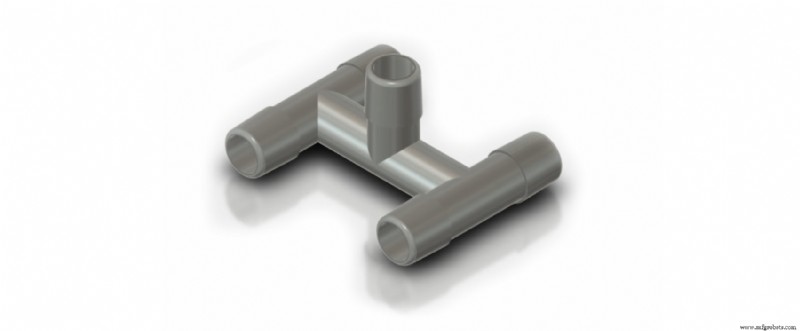
Más información
Download STL
In several hospitals there is a lack of some important elements related to respirators and necessary when treating a patient with respiratory complications. This is the case of the Venturi valve , used to regulate the oxygen concentration that is introduced to the patient through the respirator.
There are several designs available to users, such as this one from the Cults platform.
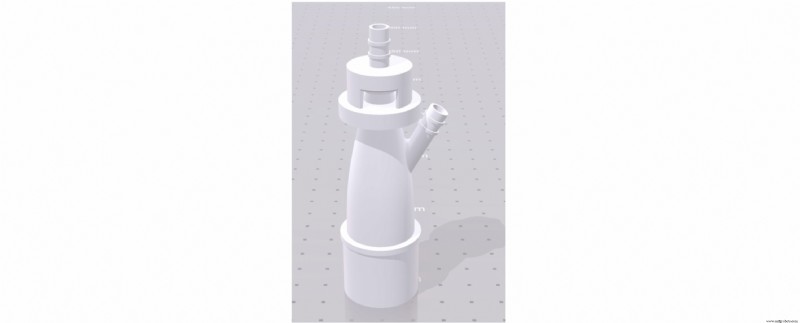
Download STL from Cults
Other devices
In addition to PPE and specific devices for the treatment of patients affected by COVID-19, different tools are being developed to avoid the contagion by indirect contact to which anyone is exposed in their daily activity (door and window handles, buttons for elevators, etc.).
The StopCovid-19 ring is an easy to print ring, designed to press switches and buttons without physically touching them.
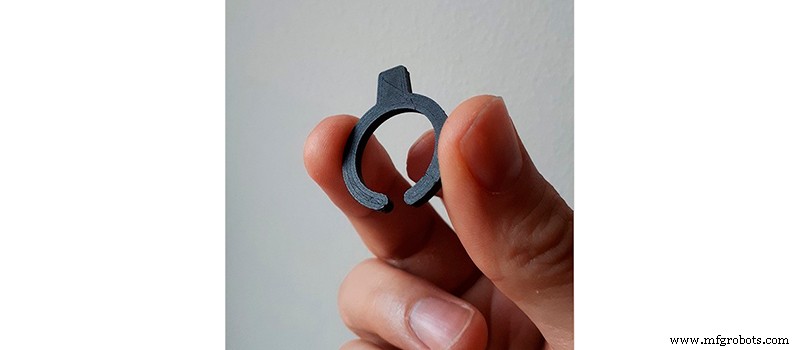
Download STL from Cults
Companies like Materialise have developed a device for attaching to door handles, so that they can be opened without using your hands. Different versions of this tool, adapted to different handle formats (cylindrical, rectangular, circular, etc.) can be downloaded free of charge from its website.

Download STL from Materialise
Combining the usefulness of the previous two, there is LU-Touch :A tool for opening and closing doors and windows, and at the same time a push-button for buttons and switches. LU-Touch can be downloaded for free and printed on any 3D FDM printer. In addition, if you do not have a 3D printer, it can be purchased already printed.
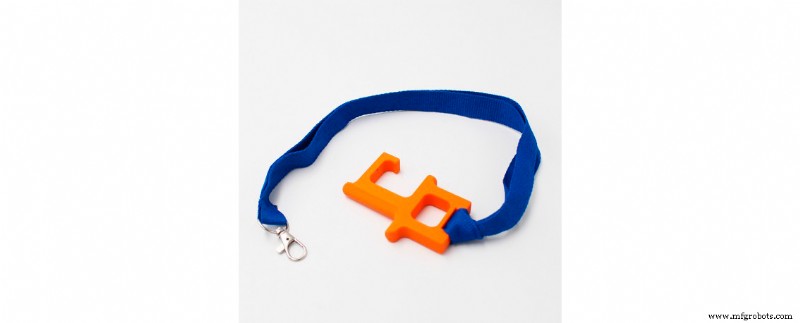
Download STL from Thingiverse
Thanks to the use of these tools, it's possible to minimize the possibility of contagion due to indirect contacts in daily activity. For greater safety, it's necessary to disinfect the tools always after use. It should also be remembered that the use of this type of tool does not exempt from applying the recommended safety rules:wash your hands regularly, do not touch your face, etc.
Specific materials
Among the specific materials to manufacture personal protective equipment, we highlight PLActive and MDFlex for their antimicrobial and antiviral qualities. This material is also recommended for printing expansion devices and valves adapted to self-contained respirators.
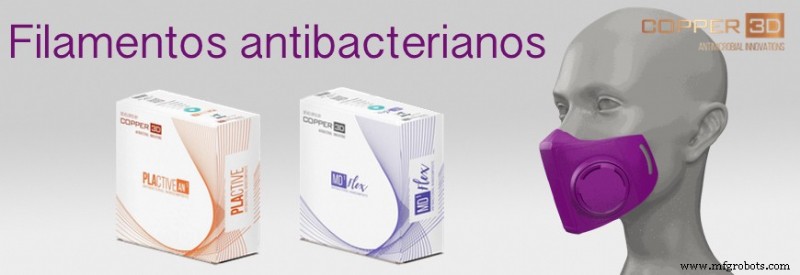
Common materials
For the manufacture of screens or valves that, due to their use, do not need to be composed of biocompatible or antibacterial materials, basic materials can be used in 3D FDM printing, such as PLA or PETG; since these elements do not require specific properties, although it's true that they require some rigidity and it's not recommended to use flexible materials such as Flexfill or FilaFlex.
With these free download files, any user with a FDM 3D printer and any of the aforementioned materials can contribute their bit to help stop the pandemic and the alarming situation we are currently experiencing.





 This screen design consists of a rigid structure with a flexible and transparent acetate plastic sheet. The rigid structure is 3D printed and the plastic acetate sheet is then adapted as a screen. The RC1 version allows more parts to be printed in the same printing process, while the RC2 version provides slightly higher protection and is more comfortable to wear.
This screen design consists of a rigid structure with a flexible and transparent acetate plastic sheet. The rigid structure is 3D printed and the plastic acetate sheet is then adapted as a screen. The RC1 version allows more parts to be printed in the same printing process, while the RC2 version provides slightly higher protection and is more comfortable to wear.





